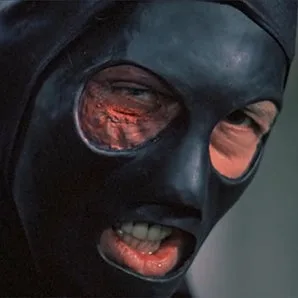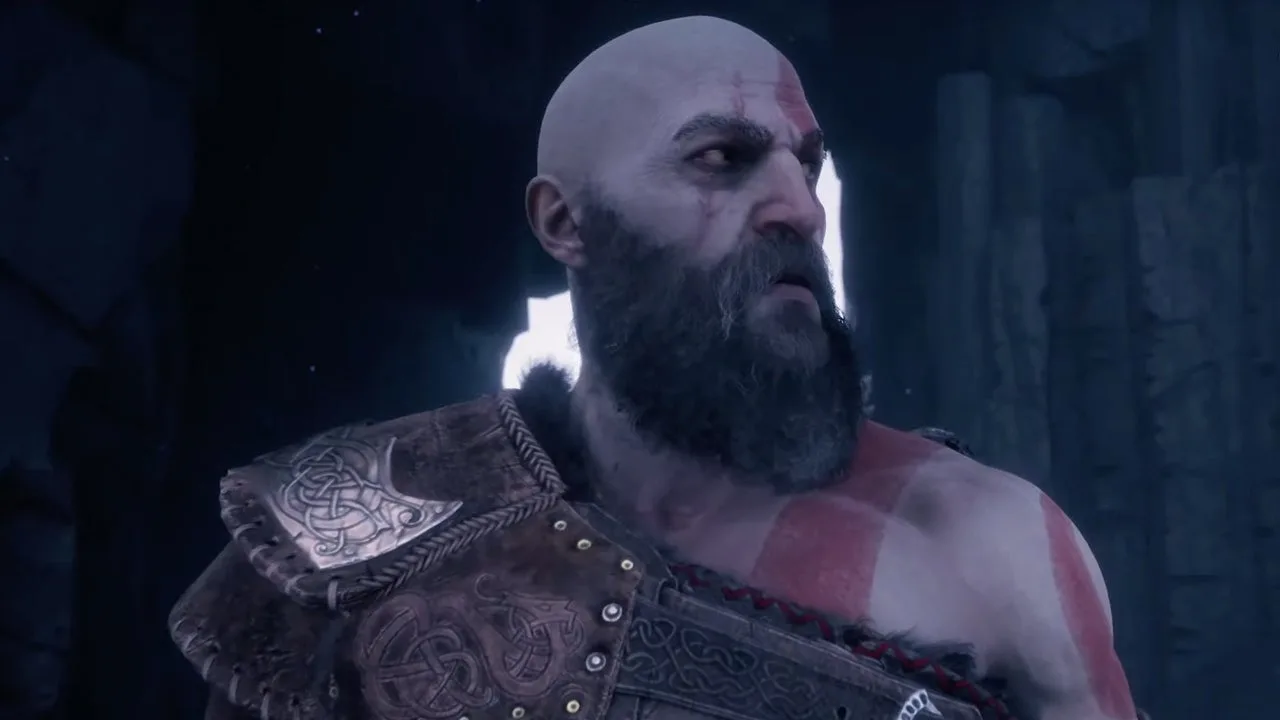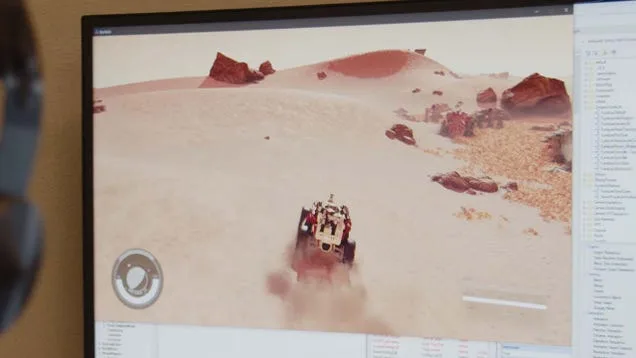“The world doesn’t want to be saved.”
So says Frankenstein, David Carradine’s warped freedom fighter, in Death Race 2000, the campy (but serious!), fun (but violent!), farcical (but prescient!) sci-fi actioner. Directed by Paul Bartel, the 1975 film posits a world 25 years into its own future where the United States has morphed into a totalitarian nightmare. But for modern viewers, watching today almost a quarter century after the Death Race was supposed to have arrived, Bartel’s film hits uncomfortably close to home at times.
After a title screen which appears to literally be a series of cheap pencil drawings – did I mention the film comes from famed low-budget impresario Roger Corman? – we find ourselves in the middle of a marching band as it belts out “The Star-Spangled Banner.” But something seems off. There’s a strange insignia on the band uniforms, on the flag flying in the wind, everywhere – a clenched fist with a lightning bolt nestled inside it. As the crowd begins to take their seats in an outdoor arena, which is perched in front of a (cheaply rendered – this budget is stretched to the seams) futuristic New York City, we see someone with a Nazi banner even as the national anthem mutates into queasy, all-is-not-well synths, implying that the country that anthem stands for has also been mutated. Like his protagonist, it’s a world Bartel doesn’t necessarily think we can come back from either.
You see, after the “World Crash of ’79,” things went from bad to worse, as the president – that’s Mr. President to you – moved abroad and the annual Transcontinental Road Race became the biggest mass-media opiate since social media. (Well, before social media, but you get the idea.) It’s a cross-country race, yes, but it’s also a free-for-all where no pedestrian is safe, and the more vulnerable you are, the more points a driver can score for running you over. As the TV announcer Junior Bruce (The Real Don Steele) says later in the film, “The race is the symbol of everything we hold dear – our American way of life! Sure it’s violent, but that’s the way we love it. Violent! Violent! Violent!”
Enter Frankenstein – “Frankenstein the legend, Frankenstein the indestructible,” to hear Junior describe him. Seemingly the closest thing the nation has to a hero, Carradine’s character is said to have survived the carnage of past years’ races and won more than once, but he’s also paid the price, judging by his scarred and masked face. He’s back for the twentieth annual race here, and Frankenstein’s fans are practically frothing at the mouth with excitement: “Half a face and half a chest and all the guts in the world!” the eminently quotable Junior yells as the veteran driver speeds onto the track.
Frankenstein eventually proves to be much more than he appears, but Death Race 2000’s terrifyingly ridiculous world centers itself on his legendary track record as a murderer of innocent men, women and children. As the Bipartisan Party’s Deacon sermonizes at the start of the race, the world is about to get a new American champion “to behold in awe, in respect, in fear.” And what better way to ensure that fear than with a strongman who shows no mercy, no empathy, and no compunction about killing those who, quite literally, stand in his way? That the masses have embraced this form of entertainment/governance is just blood-red icing on the Death Race cake.
Bartel is clearly having fun with the film’s concept, and for each body that is run over and erupts fake-looking blood everywhere, there’s a joke about, say, the French being the true enemy of the people for ruining our great American telephone system. But one senses that Corman (who produced) was a great balancing force for Bartel, making sure that Death Race 2000 was also giving the people of 1975 what they wanted: fast cars, naked flesh, and, well, bodies getting run over and erupting with fake-looking blood. There’s a synthesis that the two achieved somehow. For example, when one victim gets run over and a bag of blood explodes everywhere, it’s accompanied by a comedic sound not unlike a balloon popping followed by a comedic whistle. One for you, one for me seems to be where Bartel and Corman landed.
Still, somewhere along the way, the film also manages to say something. Perhaps it’s more obvious 49 years later, now that we’re long past the actual year 2000 when, come to think of it, the French were to soon become the focus of many Americans’ ire, as were their fries. There’s also the obvious reality TV comparisons one can make to the race, of course, but the state of the media seems prophetic in the film too, where the young-skewing idiot influencer Junior Bruce (he’s your “buddy buddy” he assures us) is joined by Carle Bensen’s Harold, an ersatz Walter Cronkite type, and Joyce Jameson’s nightmarish chat-show host whose name is literally Grace Pander. The president pontificates about “minority privilege,” where the population toils so that the one percent can reap the benefits. And most alarming of all, today the idea of Nazis running over people, and our leaders defending those Nazis, isn’t such an outlandish concept.
And that brings us back to Frankenstein believing that the world doesn’t want to be saved. Carradine’s character is far from the monster his name – and introduction in the film – would have us believe. In time, we learn that he’s trying to fight the horrors of this world (and that the very idea of Frankenstein is a construct created to help keep the system running), but that his plan is just to assassinate the president. It’s only through the unlikely – OK, preposterous, if wonderfully so – love affair that develops between him and his new navigator (and secret rebel) Annie Smith (Simone Griffeth) that allows the living legend to realize that perhaps there is room for a world after the Transcontinental Road Race after all.
What better way to ensure fear than with a strongman who shows no mercy, no empathy, and no compunction about killing those who, quite literally, stand in his way?
Indeed, Frankenstein is slowly disrobed throughout Death Race 2000’s running time even as more aspects of his life and true agenda are unveiled, starting as a masked, caped, leather-clad bogeyman and culminating in (what seems to be) a completely nude freedom fighter at the climax, before being reborn in an all-white suit for the film’s denouement. Driving home the divide between the public’s perception of Frankenstein and the real man beneath the mask is Paul Chihara’s score; whenever a moment of tenderness occurs between Frankenstein and Annie, the composer kicks into a sweeter, more melodic mode that would almost be jarring if not for it being so effective.
As for the concept of the navigator, it falls firmly into the Corman side of the equation, as each driver in the Death Race has an attractive assistant whose function seems to be lover as much as navigator. This ensures nude massages, innuendo, and sex scenes, ticking off boxes on the producer’s recipe for exploitation success. But the opposing drivers and their navigators are also made up of an amusing collection of familiar faces, not the least of which is Sylvester Stallone as “Machine Gun” Joe Viterbo (a year out from Rocky), as well as Mary Woronov (Night of the Comet), Martin Kove (The Karate Kid), and Gopher from The Love Boat himself, Fred Grandy. This group brings a level of fun to the action, no doubt thanks to Bartel, which compensates for Carradine’s more driven and serious character (though Frankenstein does get a line about a “hand grenade” that cannot be unheard).
Carradine is great as Frankenstein. Early on, as Bartel teases out his first appearance, the actor does a rendition of Boris Karloff’s hands flailing as he staggers away from the press corps (his father, John, was in several Frankenstein movies back in the day). Later in the film, one of his devoted followers offers herself in sacrifice on the road. Frankenstein coldly accepts the offering, not for the points or to win the game, but because he’s giving the girl what she wants. Annie asks why she did it. His reply? “To show me she loves me.” She didn’t want to be saved either.
Death Race 2000 is a bit of an outlier as far as being a sci-fi movie from the first half of the 1970s in that it seems to offer a happy ending. The world doesn’t end, the heroes don’t get killed off, the Soylent Green isn’t people. No, in fact, Frankenstein takes over as the new president and marries Annie, and her do-gooding, liberal grandmother (Harriet Medin) becomes his Minister for Domestic Security. The race is even abolished! But the thing is, the rebels have proven almost entirely ineffective throughout the film. Why should we think that things are going to change now that they’re in charge?
For one thing, one of Frankenstein’s first acts as president is… to run Junior over with his car for being annoying.
And the crowd goes wild.
Talk to Executive Editor Scott Collura on Twitter at @ScottCollura, or listen to his Star Trek podcast, Transporter Room 3. Or do both!



